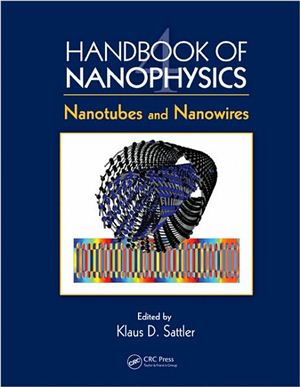CRC Press, 2010. - 788 pp.
Intensive research on fullerenes, nanoparticles, and quantum dots in the 1990s led to interest in nanotubes and nanowires in subsequent years. "Handbook of Nanophysics: Nanotubes and Nanowires" focuses on the fundamental physics and latest applications of these important nanoscale materials and structures. Each peer-reviewed chapter contains a broad-based introduction and enhances understanding of the state-of-the-art scientific content through fundamental equations and illustrations, some in color. This volume first covers key aspects of carbon nanotubes, including quantum and electron transport, isotope engineering, and fluid flow, before exploring inorganic nanotubes, such as spinel oxide nanotubes, magnetic nanotubes, and self-assembled peptide nanostructures. It then focuses on germanium, gallium nitride, gold, polymer, and organic nanowires and their properties. The book also discusses nanowire arrays, nanorods, atomic wires, monatomic chains, ultrathin gold nanowires, and several nanorings, including superconducting, ferromagnetic, and quantum dot nanorings.
Nanophysics brings together multiple disciplines to determine the structural, electronic, optical, and thermal behavior of nanomaterials; electrical and thermal conductivity; the forces between nanoscale objects; and the transition between classical and quantum behavior. Facilitating communication across many disciplines, this landmark publication encourages scientists with disparate interests to collaborate on interdisciplinary projects and incorporate the theory and methodology of other areas into their work.
Intensive research on fullerenes, nanoparticles, and quantum dots in the 1990s led to interest in nanotubes and nanowires in subsequent years. "Handbook of Nanophysics: Nanotubes and Nanowires" focuses on the fundamental physics and latest applications of these important nanoscale materials and structures. Each peer-reviewed chapter contains a broad-based introduction and enhances understanding of the state-of-the-art scientific content through fundamental equations and illustrations, some in color. This volume first covers key aspects of carbon nanotubes, including quantum and electron transport, isotope engineering, and fluid flow, before exploring inorganic nanotubes, such as spinel oxide nanotubes, magnetic nanotubes, and self-assembled peptide nanostructures. It then focuses on germanium, gallium nitride, gold, polymer, and organic nanowires and their properties. The book also discusses nanowire arrays, nanorods, atomic wires, monatomic chains, ultrathin gold nanowires, and several nanorings, including superconducting, ferromagnetic, and quantum dot nanorings.
Nanophysics brings together multiple disciplines to determine the structural, electronic, optical, and thermal behavior of nanomaterials; electrical and thermal conductivity; the forces between nanoscale objects; and the transition between classical and quantum behavior. Facilitating communication across many disciplines, this landmark publication encourages scientists with disparate interests to collaborate on interdisciplinary projects and incorporate the theory and methodology of other areas into their work.

